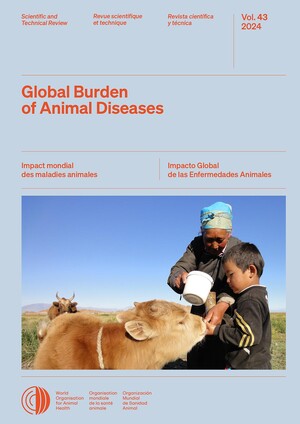
Co-infection of pigs with Taenia solium cysticercosis and gastrointestinal parasites in Eastern and Western Uganda
Abstract
A study was carried out in Kamuli and Hoima districts in Eastern and Western regions of Uganda to determine the Taenia solium porcine cysticercosis (PCC) and gastrointestinal (GI) parasites co-infection status in pigs. One hundred sixty-one households were selected randomly and visited between November and December 2019. A household questionnaire was administered, and faecal and blood samples were collected from at least one pig older than 3 months per household. A blood sample was obtained from a jugular venipuncture, and a rectal faecal sample was obtained. Taenia spp. circulating antigen levels in the sample sera were tested using a commercial enzyme-linked immunosorbent assay kit, apDia™ cysticercosis Ag ELISA. The modified McMaster technique was used to identify and quantify the GI parasites. The apparent animal-level seroprevalence for PCC was 4.8% (95% CI 2.7–7.1) and differed across the two districts (p = 0.018). At the pig herd level, the prevalence was 9.7% (95% CI 5.5–14.4). The prevalence of the different nematode eggs and coccidian oocysts in the two districts was as follows: strongyles 79.0% (95% CI 74.3–83.6), coccidia 73.3% (95% CI 68.3–78.6), Trichuris spp. 7.4% (95% CI 4.9–10.6), Strongyloides ransomi 2.1 (95% CI 0.7–3.5) and Ascaris spp. 4.9 (95% CI 2.8–7.4). Overall, across the two districts, the arithmetic mean for the oocysts per gram (OPG) for coccidia was 2042.2 ± 5776.1, and eggs per gram (EPG) were the highest in strongyles 616.1 ± 991. Overall, 57.4% of the porcine cysticercosis seropositive pigs were also positive for at least one of the gastrointestinal helminths which included strongyles, Strongyloides ransomi, Trichuris spp. and Ascaris spp. The co-infection status of pigs with both PCC and GI parasites demonstrated by this study can provide an incentive for integrating the control and management of both parasites with oxfendazole. Further studies are required to understand the feasibility of using oxfendazole including cost–benefit analysis and the acceptability by local stakeholders for the control of T. solium cysticercosis and gastrointestinal parasites in pigs.
Citation
Ngwili, N., Thomas, L., Githigia, S., Muloi, D., Marshall, K., Wahome, R. and Roesel, K. 2022. Co-infection of pigs with Taenia solium cysticercosis and gastrointestinal parasites in Eastern and Western Uganda. Parasitology Research 121(1): 177–189.








